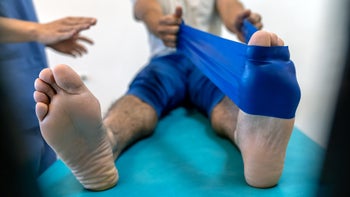
How Long Does a Sprained Ankle Take to Heal? Understanding Recovery Time and Treatment
Key takeaways:
An ankle sprain is one of the most common injuries. It’s caused by twisting or rolling your ankle, which injures the ligaments that support your ankle joint.
Healing time for an ankle sprain varies depending on the severity of the sprain. Ankle sprains are graded from 1 to 3 depending on the ligament damage.
Grade 1 sprains are mild and heal within a couple weeks. Grade 3 sprains are more severe, requiring several weeks or even months for recovery.

You've probably sprained your ankle at some point in your lifetime. Ankle sprains are one of the most common injuries, and they affect people of all ages. They’re more likely to happen when running on uneven ground or playing sports that involve cutting or jumping. But you can also sprain your ankle during simple everyday activities.
While ankle sprains are very common and often don’t need a lot of medical treatment, recovery can still take some time. The time to heal an ankle sprain depends on how bad the sprain is. Here’s what you need to know.
How do you know when you sprained your ankle?
If you’ve rolled or twisted your ankle and have pain, it’s likely a sprain. Ankle sprains happen when your foot forcefully turns at the ankle. This damages the supporting ligaments (bands of connective tissue) that stabilize your ankle joint.
Search and compare options
Symptoms include:
Pain
Tenderness
Swelling
Bruising
Instability
Most ankle sprains occur on the outer side of your ankle. Less often, they affect the inner side or the area above your ankle joint.
How long does it take for a sprained ankle to heal?
The length of time it takes to recover from an ankle sprain depends on how bad your injury was. After an examination (and sometimes imaging), a medical professional can estimate the severity of your injury. This is done with a 3-part grading system.
Ankle sprain grades
The following ankle sprain grading scale is based on the extent of your injury. And it can help estimate your recovery time:
Grade 1 (mild): This type of injury involves small, microscopic tearing in your ligament. While this causes some pain, most of the ligaments remain intact, so your ankle is stable. Recovery is generally quick — sometimes as fast as 1-2 weeks.
Grade 2 (moderate): This injury involves a partial tear in your ligament. Symptoms are worse than with a grade 1 sprain, and there’s some ankle instability. Because of more tearing, healing takes longer — about 3-6 weeks.
Grade 3 (severe): The most severe sprain involves tearing through most or all of your ligament. This causes significant pain and instability. Recovery may take months to heal.
Is a high ankle sprain different from a “regular” ankle sprain? Yes, there are a few differences. Learn why high ankle sprains take longer to heal.
Long-standing ankle problems can lead to popping and cracking. Does this mean anything? Learn when to get medical attention for it.
Ankle sprains are common among runners. Runners are prone to overuse injuries like shin splints. The good news is that most running injuries are preventable.
Another important factor in recovery time is how well you can tolerate being on your feet. If you can put weight on your foot right after the injury, it’s usually a good indicator that you’ll recover more quickly.
What causes an ankle sprain?
A sprain usually happens from rolling or twisting your ankle. Inversion, where your foot turns down and inward relative to your lower leg, can cause a sprain on the outside of your ankle. This motion stretches and injures the ligaments that stabilize your ankle.
What are the best ankle sprain treatments?
Ligaments are generally slow to heal. Treatment usually follows three phases.
Phase 1
The initial focus is on managing your pain and swelling. The R.I.C.E. method is commonly recommended in the beginning stages of recovery:
Rest: Avoid aggravating activities, including walking, if it’s too painful.
Ice: Apply ice or a cold pack for 20 minutes at a time, several times a day. Use a cloth or towel between your skin and the ice to prevent skin injury.
Compression: Wear an ankle brace or wrap your ankle with elastic bandages for gentle compression.
Elevation: Keep your injured ankle above the level of your heart to reduce swelling by encouraging fluid back into circulation.
Over-the-counter (OTC) anti-inflammatory medications like ibuprofen can help reduce pain and swelling. It’s best to limit their use to a short period (1 to 2 weeks).
Phase 1 also involves protecting your ankle. While mild injuries usually don’t need immobilization, moderate to severe injuries sometimes do. A cast or rigid boot can keep the ankle still and prevent aggravation of your injury. Experts recommend limiting immobilization to 7 to 10 days. Note that this is different from functional bracing, like a flexible brace or boot, which provides support and allows some motion.
Phase 2
As pain and swelling start to subside, it’s important to get your ankle moving. And it’s good to start putting weight on your foot if you haven’t already.
Rehab is very important after an ankle sprain. Damaged ligaments are unlikely to regain full strength, so strengthening the surrounding muscles is important to support your ankle. You’ll also work on mobility and balance in this phase of recovery.
Research supports a formal physical therapy (PT) program over home exercises when possible. PT leads to better gains in motion, strength, and return to activities after ankle sprain.
Phase 3
This phase involves more rigorous exercises. You’ll continue to work on mobility (stretching), balance, and strength. Exercises progress to include more advanced activities like cutting, jumping, and other sport-specific movements (if applicable).
Completing a rehab program is important because it reduces the risk of reinjury and long-term instability.
When should you see a healthcare professional?
Here are some situations where you should get medical attention for an ankle sprain:
You sprained your ankle and can’t put weight on your foot.
Your symptoms are getting worse instead of better in the days after your injury.
You treated an ankle sprain on your own, but it hasn’t healed properly.
Depending on your injury, your primary care provider may suggest X-rays to rule out a fracture (break). They can also provide you with a brace, splint, or crutches if needed.
It’s also a good idea to see a healthcare professional if you have ongoing problems with your ankle. Ankle sprains can recur and lead to chronic instability. This risk is higher if balance and stability problems persist after your injury. In some cases, surgery is needed to reconstruct the ligament and restore stability in your ankle. An orthopedic surgeon trained in foot and ankle problems can help determine if this is a good option for you.
The bottom line
Ankle sprains damage the ligaments supporting the ankle joint. The time it takes for an ankle sprain to heal will vary depending on how bad the sprain is. Mild or moderate sprains may heal in a few weeks, while major sprains can take months. Once sprained, ligaments don’t usually regain their full strength. So, it’s important to rehab your ankle joint for better stability and to prevent further injury.
Why trust our experts?



References
Gomes, Y. E., et al. (2022). Diagnostic accuracy of the Ottawa ankle rule to exclude fractures in acute ankle injuries in adults: A systematic review and meta-analysis. BMC Musculoskeletal Disorders.
Herzog, M. M., et al. (2019). Epidemiology of ankle sprains and chronic ankle instability. Journal of Athletic Training.
Hunt, K. J., et al. (2020). Open Brostrom for lateral ligament stabilization. Current Reviews in Musculoskeletal Medicine.
Kruckeberg, B. M., et al. (2022). Sprained ankle. OrthoInfo.
Ruiz-Sánchez, F. J., et al. (2022). Management and treatment of ankle sprain according to clinical practice guidelines: A PRISMA systematic review. Medicine.
Tartaglione, J., et al. (n.d.). What is an ankle sprain? FootCareMD.
Vuurberg, G. (2017). Diagnosis, treatment and prevention of ankle sprains: Update of an evidence-based clinical guideline. British Journal of Sports Medicine.
Wagemans, J, et al. (2022). Exercise-based rehabilitation reduces reinjury following acute lateral ankle sprain: A systematic review update with meta-analysis. PLoS One.

























